|
The Great Dismal Swamp and the American Civil War
Introduction
The Great Dismal
Swamp is a marshy area in the Coastal Plain Region of southeastern Virginia and northeastern North Carolina, between Norfolk,
Virginia, and Elizabeth City, North Carolina. Although during the Civil War (1861-1865) the Battle of South Mills was the only fight near the canal itself, the swamp was host to runaway slaves, deserters, and even bushwhackers. Early
in the war, Confederate President Jefferson Davis expressed an interest in sending the Cherokee of western North Carolina
into the Dismal Swamp to police it, but their chief contended that the Eastern Cherokee knew only the mountains, and to send
them into a foreign swamp would likely eradicate the small tribe known as the Eastern Band. Davis then dropped idea,
and the Cherokee Indians would soon form the nucleus of the Thomas Legion, the namesake of this site.
Great Dismal Swamp
While the Great Dismal Swamp was host to a vast variety of birds and four-legged
critters, it was the snakes, namely the aggressive water moccasin, and mosquitoes that poised the greatest
threat to the individual who tramped through it. Allergies. Now that was another threat. Author and Poet John Boyle O'Reilly, Athletics
and Manly Sport (1888), said that the Dismal Swamp was hundreds of miles of waterlogged forest,
infested with repulsive and deadly creatures, reptile and beast, bear, panther, wild-cat and snake. The Dismal Swamp is
an agony of perverted nature. It is Andromeda, not waiting for the monster, but already in his grasp, broken and silent under
the intolerable embrace. Astonished after visiting the Dismal Swamp, George Washington, in 1763, said that
"all the rivers in the swamp flowed out of it instead of into it."
The Dismal Swamp
Canal was completed in 1805 and is the oldest continually operating man-made canal in the United States. It is one of the last large wild areas remaining in the Eastern United States. Some estimates place the size of the original swamp at over 1,000,000
acres, stretching from the Norfolk, Virginia, area to Edenton, North Carolina. The Great Dismal Swamp National Wildlife Refuge
was created in 1973 when the Union Camp Corporation of Franklin, Virginia, donated 49,100 acres of land after centuries
of logging and other human activities devastated the swamp's ecosystems. The refuge consists of over 112,000 acres of forested wetlands, and Lake Drummond, a 3,100-acre
natural lake, is located in the heart of the swamp. The canal would become a casualty of war and be left in a deplorable
condition.
| The Great Dismal Swamp Canal |
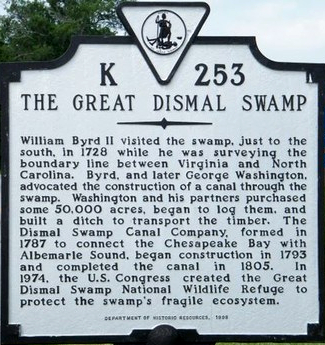
|
| Great Dismal Swamp Canal and the Civil War |
Summary
During the American Civil War (1861-1865) the canal was in an important
strategic position for Union and Confederate forces. In April, 1862, upon learning of rumors that the canal would be used
to help the Confederate ironclad escape from Hampton Roads to the Albemarle Sound in North Carolina, Union General Ambrose
E. Burnside sent General Jesse L. Reno from Roanoke Island to destroy the Culpepper Locks near South Mills on the Dismal Swamp
Canal. Reno's 3,000 troops disembarked from their transports near Elizabeth City on April 18.
The Union troops advanced the following morning on an exhausting march toward
South Mills where Confederate Colonel Ambrose R. Wright posted his 900 men to command the road to the town. Reno encountered
Wright's position at noon. The Confederates' determined fighting continued for four hours until their artillery commander,
Captain W. W. McComas, was killed. To avoid being flanked, Wright retired behind Joy's Creek, two miles away. General Reno
did not pursue them because of his losses and his troops' exhaustion. That evening he heard a rumor that Confederate reinforcements
were arriving from Norfolk and ordered a silent march back to the transports near Elizabeth City. The losses were estimated
at 114 Union and 25 Confederate soldiers. The Battle of South Mills was the only battle action near the canal, but wartime
activity left the canal in a terrible state of repair. The repairs and maintenance needed by the canal made travel difficult.
| Great Dismal Swamp and the Civil War |
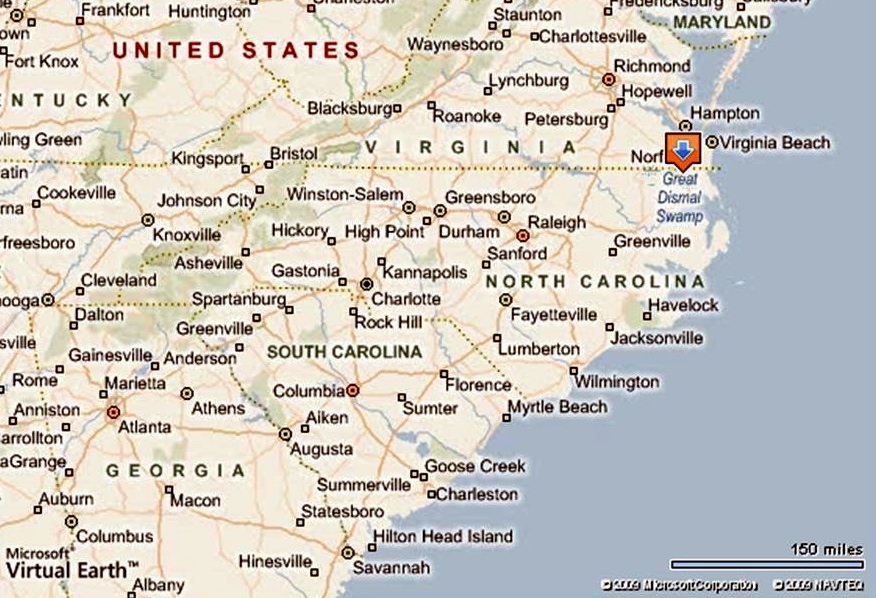
|
| Location of Great Dismal Swamp, North Carolina |
American Civil War
The Dismal Swamp Canal opened
to waterway traffic in 1805 and became a "prize of war" during the Civil War. In the early months of war, southerners used
the canal to transport much-needed supplies. W. F. Lynch, Commander of the C.S.S. Sea Bird, a side-wheel steamer,
received naval supplies via the canal when he was in charge of a tiny fleet defending Roanoke Island. After Roanoke Island fell into Union hands on February 8, 1862, Lynch decided
to take a position at Elizabeth City. However, on February 10, units of Admiral Goldsborough's fleet captured Elizabeth City and
the Sea Bird was rammed and sunk by the U.S.S. Commodore Perry. Two other ships fled northward up the Pasquotank River to the Dismal
Swamp Canal en route to Norfolk.
While C.S.S. Beaufort made it safely through the canal to Norfolk,
C.S.S. Appomattox was two inches too wide to enter the locks. Rather than let his ship be captured by the enemy,
the captain set it on fire.
Union forces did not attempt to destroy the locks of the Dismal Swamp Canal until two months later.
According to The Rebellion Record, Frank Moore, Editor, it was known that "Rebel entrenchments and batteries to protect
the canal" had been installed at South Mills.
This was also the time of the "ironclads," with the battle between the Monitor
and the Merrimack at Hampton Roads on March 9, 1862.
Word reached General Burnside, who had established a position in New Bern, that Confederates were building ironclads in Norfolk and intended to bring
them south through the Dismal Swamp and Currituck Canals. Therefore, General Burnside ordered General Jesse L. Reno to move
troops to South Mills and blow up its locks, then proceed to the Currituck
Canal and destroy its banks.
| Great Dismal Swamp during the Civil War |
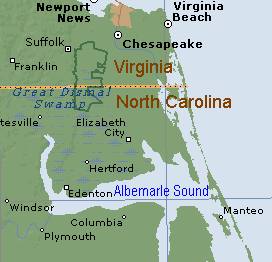
|
| Location of the Great Dismal Swamp |
| Great Dismal Swamp Civil War History |
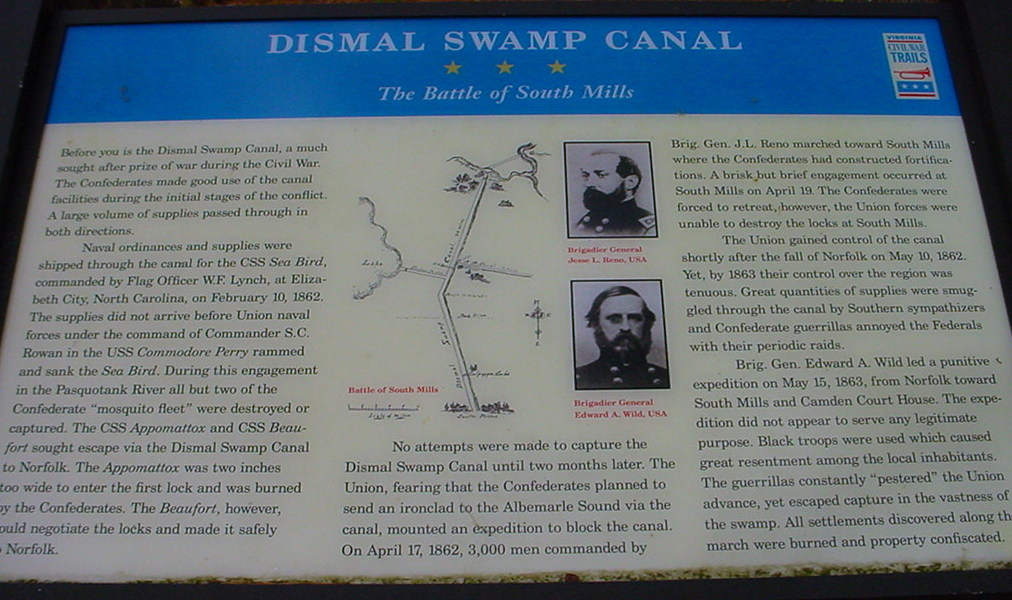
|
| Great Dismal Swamp and the Civil War |
| Great Dismal Swamp Canal |
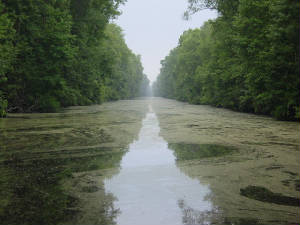
|
| Great Dismal Swamp Canal |
(Left) In the early days of the colonies,
hunters, fishermen, and loggers used the Great Dismal Swamp for profit and adventure, utilizing the rich resources of the
area as the cities of Virginia and North Carolina grew ever larger. The Great Dismal Swamp was also used by many slaves
to gain their freedom, either by working as bondsmen and hiring themselves out to boat work or shingle production or as a
hiding place for runaway slaves. Some established ‘maroon’ colonies on the higher, drier parts of the swamp,
living off the land and what they could steal. Even in his original survey of the swamp
Colonel William Byrd II had written, “It is certain many Slaves shelter themselves in this Obscure Part of
the World, nor will any of their Righteous neighbors discover them.”
General Reno moved his command of 3,000 men from
Roanoke Island on April 17 and transported them by water to Elizabeth City.
From there, they marched north to South Mills, accompanied by three wagons loaded with explosive materials to be used on the
locks. After an exhausting all-night march, at noon Reno's
men encountered the Third Georgia Regiment, commanded by Colonel A. R. Wright, about three miles below the locks. The two
sides engaged at the edge of the woods at the north end of Sawyers Lane. On April 19, for five hours the 750
defenders withstood all Union assaults until their artillery commander, C.S. Captain W. W. McComas, was killed. Running low
on ammunition and to avoid being flanked, Wright withdrew his troops to a new position behind Joy's Creek, about a mile away.
Unaccustomed to the oppressive heat and after sustaining numerous casualties, the Union forces did not pursue and, in fact,
rapidly withdrew back to their transports near Elizabeth City, leaving their dead and wounded behind and the Canal intact.
Soon afterwards, however, Norfolk surrendered on May 10, 1862, and Union troops transported
goods on the Canal. Leroy G. Edwards, Collector of Tolls for the Dismal Swamp Canal Company, testified: "In the latter part
of the summer of 1862, the U.S. forces
took possession of the work. They gave us much trouble ... goods were carried through under military permits. I asked payment
of tolls, which were refused."
| Great Dismal Swamp Region Map |
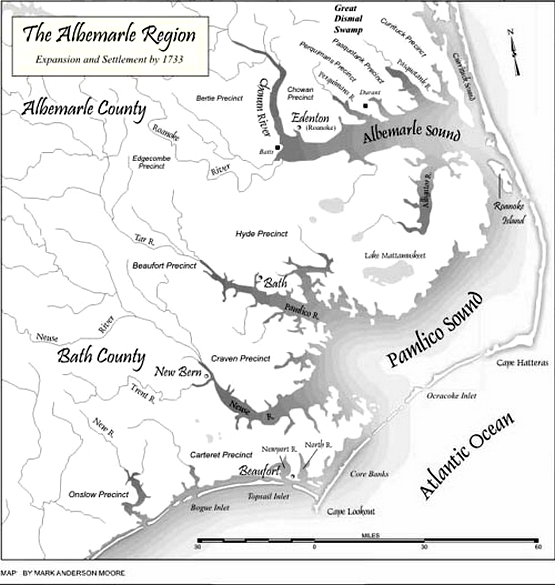
|
| North Carolina Coast and the Dismal Swamp |
| Great Dismal Swamp, NC |
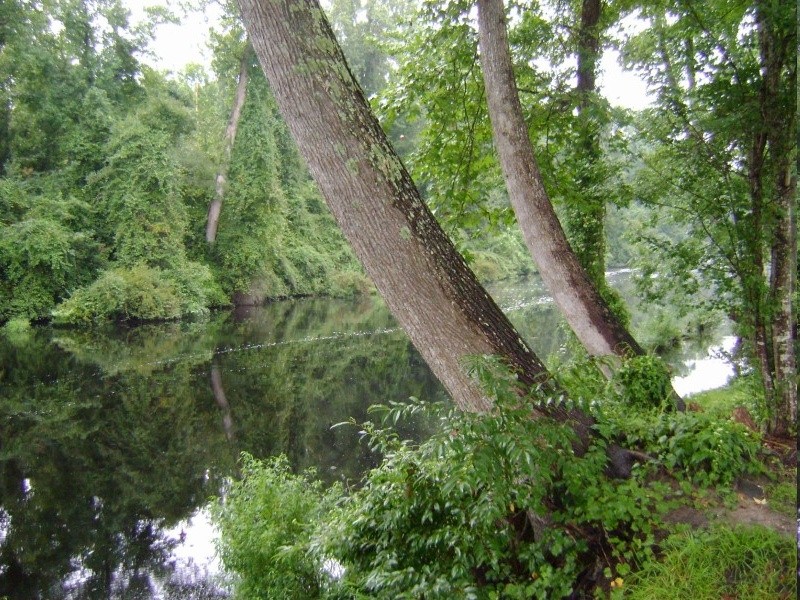
|
| Great Dismal Swamp and the Civil War |
(About) The Great Dismal Swamp surely doesn’t
draw visitors by the allure of its name, for there could hardly be less attractive appellation for the more than 111,000 acres
of swampy forest land now a National Wildlife Refuge and popular spot for fishing, birding, hiking, biking, boating, and wildlife
observation. Straddling the border of southeast Virginia and northeast North Carolina, the name of the Great Dismal Swamp
belies the natural beauty of the place as well as its varied history. From the time of its discovery by settlers in the early
seventeenth century, the Great Dismal Swamp has captured imaginations, setting both minds and feet roving among the watery
realm of juniper and cypress.
During this time, a sizable number of Confederate
sympathizers and deserted soldiers were in hiding in the Swamp, making periodic raids on Federal boats. Official Army records
document that on December 5, 1863, Brigadier General Edward A. Wild led forces from Norfolk to
South Mills and Camden Court House to capture these rebel forces. However, the two small steamers carrying supplies for his
forces were by "some unaccountable blunder ... sent astray through the wrong canal" and did not catch up with General Wild
until he arrived at Elizabeth City.
In the vastness of the Great Dismal Swamp, the Rebels eluded this expedition. All settlements discovered on this march were
burned and confiscated, innocent men were hanged and women were taken as hostages. North Carolina Governor Zebulon B. Vance
referred to General Wild's actions as a "disgrace to the manhood of the age. Not being able to capture soldiers, they war
upon defenseless women. Great God! What an outrage!" The Union forces returned to Norfolk on
December 24, leaving a trail of destruction behind them.
Following the surrender at Appomattox on April 9, 1865, the Canal was returned to its owners
in a deplorable condition. See also North Carolina Coast and the American Civil
War and North Carolina Coast and
the American Civil War: The Operations, Campaigns, and Expeditions.
| Civil War North Carolina & Great Dismal Swamp Map |
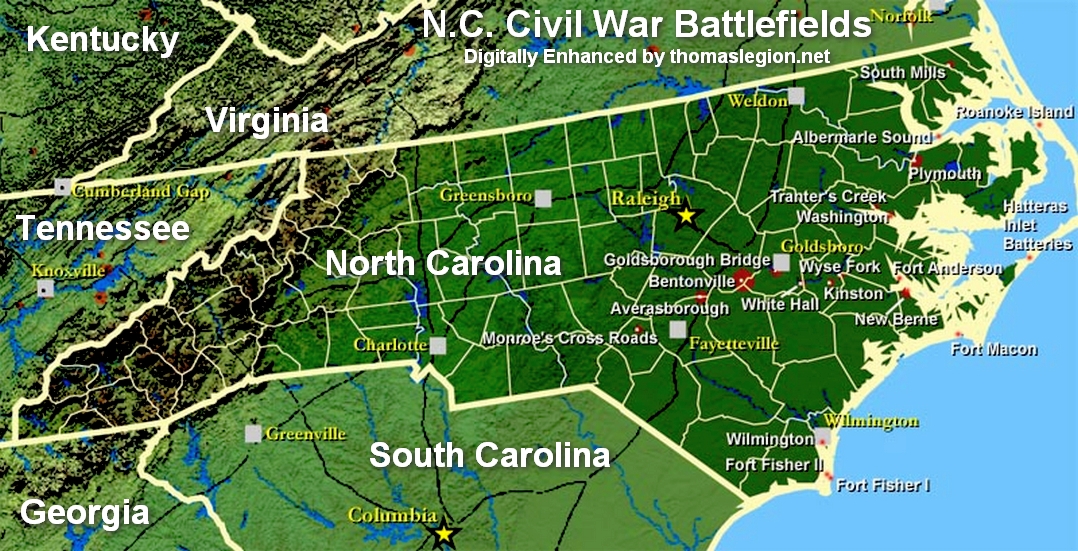
|
| North Carolina Map of Civil War Battles and Battlefields |
| Great Dismal Swamp Canal and the Civil War |
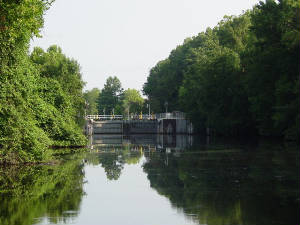
|
| South Mills Great Dismal Swamp Canal Lock Entrance |
| North Carolina Coast and the Civil War |
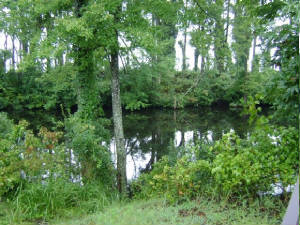
|
| Great Dismal Swamp and the Civil War |
Today
Visitor’s today will see a slightly
less wild and intimidating Great Dismal Swamp, tamed as it was by agriculture and logging, but the historical connections
still remain, seen in the various canals and remnants of African-American communities and homesteads. The swamp still
provides excellent opportunities to explore the natural habitat that so astounded its first visitors. Over 200 hundred species
of birds nest in the swamp, as well as otter, bats, raccoon, mink, foxes, squirrels, deer bobcats, and bears. Aside from wildlife
viewing, visitors can boat and fish in the lakes and canals, and hike or bike the many
trails. Hunting is also allowed during certain periods of the year.
The Great Dismal Swamp itself is indeed both beautiful and hazardous, as well as
unique in many ways. While most swamps are located in places lower than their surrounding lands, the Great Dismal Swamp is
actually on a hillside 20 feet above sea-level. In most swamps, also, the moist heat and darkness make ideal conditions
for rapid decay of matter, but the water in the Great Dismal is so acidic due to the leaching of juniper and cypress trees
that there is little bacterial growth, and as a result, debris accumulates year after year. The Great Dismal Swamp is also
one of the few places where peat is formed.
The Great Dismal Swamp National Wildlife Refuge lies wholly within the Middle
Atlantic coastal forests ecoregion. The refuge harbors a wide range of plant and animal species. Bald cypress, tupelo, maple,
Atlantic white cypress, and pine, among other tree species found on the refuge, support the fauna within. The swamp is home
to many mammals, including black bear, bobcat, otter, and weasel, as well as over 70 species of reptiles and amphibians. Lake Drummond is the center of activity in the swamp today, attracting fishermen, sightseers, and boaters. Camping
is not allowed on the refuge, but it is allowed on the Lake Drummond Reservation, a Corps of Engineers site, located at the
Feeder Ditch spillway. Access to this site is possible only by boat.
The Great Dismal Swamp National Wildlife Refuge
Headquarters are in Suffolk, Virginia, as are some trailheads, but you can still enter the swamp from the North Carolina side
through the Dismal Canal Welcome Center (2356 US Highway 17 N) at South Mills. Trail bikes are also available for visitors
to explore the paved Dismal Swamp Canal Trail.
(Sources listed at bottom of
page.)
Recommended Reading: Storm over Carolina: The Confederate
Navy's Struggle for Eastern North Carolina. Description: The struggle for control of the eastern waters of North Carolina during the War Between the States was a bitter, painful,
and sometimes humiliating one for the Confederate navy. No better example exists of the classic adage, "Too little, too late." Burdened
by the lack of adequate warships, construction facilities, and even ammunition, the South's naval arm fought bravely and even
recklessly to stem the tide of the Federal invasion of North Carolina from the raging Atlantic. Storm Over Carolina is the account of the
Southern navy's struggle in North Carolina waters and it
is a saga of crushing defeats interspersed with moments of brilliant and even spectacular victories. It is also the story
of dogged Southern determination and incredible perseverance in the face of overwhelming odds. Continued below...
For most of the Civil War, the navigable portions of the Roanoke, Tar, Neuse, Chowan, and Pasquotank rivers were
occupied by Federal forces. The Albemarle and Pamlico sounds, as well as most of the coastal towns and counties, were also
under Union control. With the building of the river ironclads, the Confederate navy at last could strike a telling blow against
the invaders, but they were slowly overtaken by events elsewhere. With the war grinding to a close, the last Confederate vessel
in North Carolina waters was destroyed. William T. Sherman
was approaching from the south, Wilmington was lost, and the
Confederacy reeled as if from a mortal blow. For the Confederate navy, and even more so for the besieged citizens of eastern
North Carolina, these were stormy days indeed. Storm Over Carolina describes their story, their struggle, their history.
Recommended Reading: Ironclads and Columbiads:
The Coast (The Civil War in North Carolina) (456 pages). Description: Ironclads and Columbiads covers
some of the most important battles and campaigns in the state. In January 1862, Union forces began in earnest to occupy crucial
points on the North Carolina coast. Within six months, Union army and naval forces effectively controlled coastal North Carolina
from the Virginia line south to present-day Morehead City. Continued below...
Union setbacks in Virginia, however, led to the withdrawal of many federal soldiers from North Carolina,
leaving only enough Union troops to hold a few coastal strongholds—the vital ports and railroad junctions. The South
during the Civil War, moreover, hotly contested the North’s ability to maintain its grip on these key coastal strongholds.
Recommended Reading: The Civil War in Coastal North Carolina
(175 pages) (North Carolina Division of Archives and History). Description: From the
drama of blockade-running to graphic descriptions of battles on the state's islands and sounds, this book portrays the explosive
events that took place in North Carolina's coastal region
during the Civil War. Topics discussed include the strategic importance of coastal North
Carolina, Federal occupation of coastal areas, blockade-running, and the impact of war on civilians
along the Tar Heel coast.
Recommended Reading: Swamp Doctor: The
Diary of a Union Surgeon in the Virginia and North Carolina
Marshes (Hardcover). Description: This is my candidate for Civil War book of the year. Dr. Lowry, perhaps the most accomplished
researcher in the field, has published a series of books on the period, all of which are worthwhile, but this time he's done
something a bit different. Publishing, for the first time, the Civil War diary of a regimental surgeon, Lowry has shown admirable
restraint in adding only the introductory and bridge material (as well as the best footnotes I've ever seen) necessary for
all readers to follow the flow of events in the context of the greater war. Continued below...
Surgeon William M. Smith, having lost his first diary during the initial
fighting on the Peninsula, began another in time to capture the frustrations and confusion of the first great struggle for
Richmond;
thereafter, his regiment was posted to the Carolinas, an under-studied, but fascinating theater
of war. The diary's value lies in its straightforward readability, as well as in its frankness. Dr. Smith worries over the
loyalty of his fiancee in New York and wrestles with his
religious beliefs. He observes rarely-reported battles and skirmishes, such as the inconclusive operations on the Virginia-Carolina
line in 1862, then the subsequent forays from New Bern. In
between, the reader gets the best account I've seen of the routines of camp life, of daily behavior in occupied territory,
of how officers amused themselves (reading Les Miserables, for one thing), and even what room and board cost in the low country.
The political nonsense that penetrated even the lowest levels of both armies is included, along with a rich variety of personalities,
from selfless patriots to drunks and whoremongers. Throughout, I felt as if I were seeing the real Civil War at last, not
some historian's vision through a high-powered telescope. As trite as it is to say this, I could not put it down. This well-written,
understated book offers an incomparable window into the times, and I, for one, am grateful to Dr. Lowry for making this diary
available to the rest of us. Very highly recommended.
Recommended Reading: The Civil War in the Carolinas (Hardcover). Description: Dan Morrill relates the experience of two quite different states
bound together in the defense of the Confederacy, using letters, diaries, memoirs, and reports. He shows how the innovative operations of the Union army and navy along the coast and in the bays and rivers of the
Carolinas affected the general course of the war as well as the daily lives of all Carolinians.
In the latter part of the war, he describes how Sherman's
operation cut out the heart of the last stronghold of the South. Continued below...
The author
offers fascinating sketches of major and minor personalities, including the new president and state governors, Generals Lee,
Beauregard, Pickett, Sherman, D.H. Hill, and Joseph E. Johnston. Rebels and abolitionists, pacifists and unionists, slaves
and freed men and women, all influential, all placed in their context with clear-eyed precision. If he were wielding a needle
instead of a pen, his tapestry would offer us a complete picture of a people at war. Midwest Book Review: The Civil War in the Carolinas by civil war expert and historian Dan
Morrill (History Department, University of North Carolina at Charlotte, and Director of the Charlotte-Mecklenburg Historical
Society) is a dramatically presented and extensively researched survey and analysis of the impact the American Civil War had
upon the states of North Carolina and South Carolina, and the people who called these states their home. A meticulous, scholarly,
and thoroughly engaging examination of the details of history and the sweeping change that the war wrought for everyone, The
Civil War In The Carolinas is a welcome and informative addition to American Civil War Studies reference collections.
Sources: southmillsbattle.home.coastalnet.com;
albemarle-nc.com/camden/history/civilwar; Arnold, Robert. The Dismal Swamp
and Lake Drummond. Early Recollections. Vivid Portrayals of Amusing Scenes. Norfolk, VA: Green, Burke & Gregory, 1888;
Davis, Hubert J. The Great Dismal Swamp: Its History, Folklore, and Science.
Murfreesboro, NC: Johnson Pub. Co., 1971; Duke, Alvah. Dismal Swamp Wildlife.
Chicago: Adams Press, 1973; O’Donnell, William James. The Maroons
of the Great Dismal Swamp. Thesis: Dept. of History, University of North Carolina at Chapel Hill, 1993; Pugh,
Jesse F. and Frank T. Williams. The Hotel in the Great Dismal Swamp, and Contemporary Events Thereabouts. Old Trap, NC: J.F.
Pugh, 1964; Stowe, Harriet Beecher. Dred – A Tale of the Great Dismal Swamp.
Robert S. Levine, ed. North Carolina: University of North Carolina Press, 2006; National Park Service; Maps courtesy Microsoft
Virtual Earth and Microsoft MapPoint; University of North Carolina at Chapel Hill; Albemarle Region Map, by Mark A. Moore;
The Great Dismal Swamp National Wildlife Refuge (Suffolk, Virginia); Dismal Canal Welcome Center (South Mills, North
Carolina); Official Records of the Union and Confederate Navies; Official Records of the Union and Confederate Armies.
|

